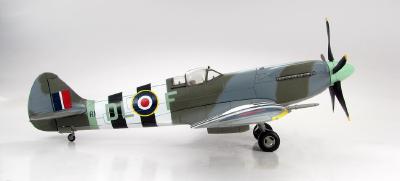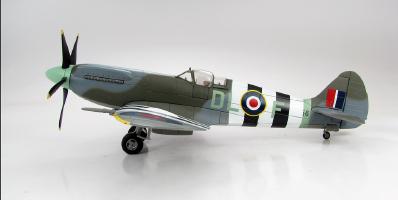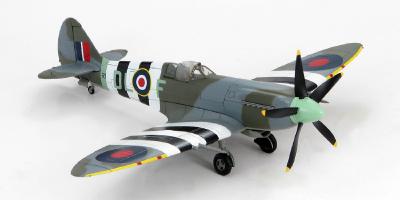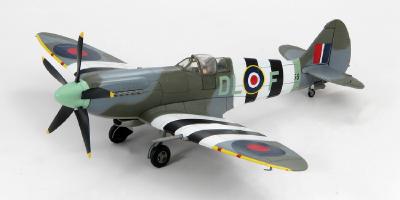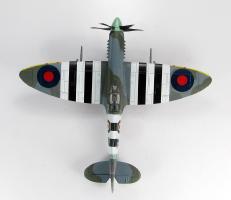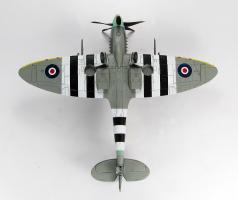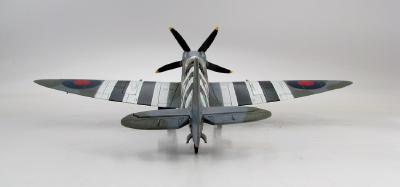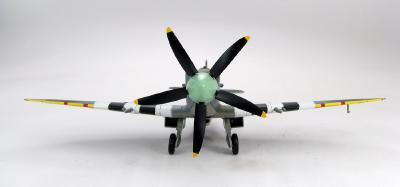Hobby Master Archive
Air Power Propellers 1/48
Spitfire
Spitfire XIV DL-F RM656 91 Squadron Jean Marie Maridor West Malling June 1944
Hobby Master 1/48 Air Power Series HA7103 Spitfire Mk. XIV, DL-F / RM656, 91 Sqn. Jean Marie Maridor, West Malling 1944
THESE ARE PRE- PRODUCTION PICTURES, NOT THE FINAL PRODUCT
1/48 scale pre-finished Die-cast metal with a minimum of plastic. Professionally painted. All markings pad applied for superb results. Cockpit slides open. Cockpit side door opens. Comes with a pilot that can be removed. Comes with display stand. Landing gear is fully retractable and can be displayed up or down. Removable wing gun covers. Propeller is metal. Extremely sought after by collectors.
Spitfire XIV specifications Basic information: Country of origin: Britain Classification: single-engine fighter Crew: 1 Production: first produced in 1943 Number produced: 957 of all XIV variants Dimensions: Wingspan: 36ft 10in (11.23m) Length: 32ft 8in (9.96m)
Performance: Powerplant: 1 X Rolls-Royce Griffon 65 12 cylinder liquid-cooled engine 2,035hp (1,517kW) Speed max: 447mph (720km/h) Range: 460 miles (740 km) on internal tanks Ceiling max: 42,978ft (13,100m)
Weight: Empty: 6,603lb (2,995kg) Maximum: 10,285lb (4,665kg)
Armament: 2 X 20mm (.078in) Hispano cannons 4 X Browning 7.7mm (0.303in) machine guns Up to a 1,000lb (454kg) payload with other options possible
“Nigeria” Squadron 91 On January 11 1941 at Hawkinge, 421 Reconnaissance Squadron was renumbered 91 Squadron. This Squadron would last until January 31 1947 when it was renumbered 92 Squadron. The Squadron accumulated 68 aircraft victories and 152 V1s during their existence.
The “Nigeria” Squadron received its name when formed. It wasn’t until they started receiving the Mk. V that there was any actual connection with their namesake country. Nigeria paid for 20 presentation aircraft each with the name “Nigeria” followed by a specific province just forward of the cockpit.
The first V1 chasing Spitfires from the 150 Wing just didn’t have enough speed to catch the missiles so when the XIVs became available the 91 Squadron was one of three assigned to the task. The thing to remember was to stay at least 150 yards away from the V1 if you are going to shoot it down; even then there was a risk of hitting flying debris or flying into burning rocket fuel. On August 3, 1944 Jean Marie Maridor, a French pilot flying with the RAF was on duty in his XIV and chasing a V1, a “Diver” as they were referred to. When he determined that the missile was headed for a military hospital he decided he had one chance to make sure the missile didn’t reach its target. He flew his Spit well within the 150 yards and opened fire. His bullets ripped through the V1 igniting it and sending molten metal in every direction. Unfortunately the explosion tore Maridor’s Spitfire apart killing him. Mission accomplished, the hospital was spared but at a great loss of a fine pilot. The remains of Maridor’s body were found outside the hospital that he had just saved. He was 24 years of age and due to be married 7 days later on August 10, 1944. Jean had accumulated a record of 4 confirmed kills, 2 more probables and 3 damaged. He also destroyed 11 V1s and sank 20 vessels. He had been the recipient of 7 medals including the DFC.
| Added to archive | 2015-11-19 |
| Last modified | 2015-11-19 |
| Leaflet | 2008-02-01 February 2008 |
